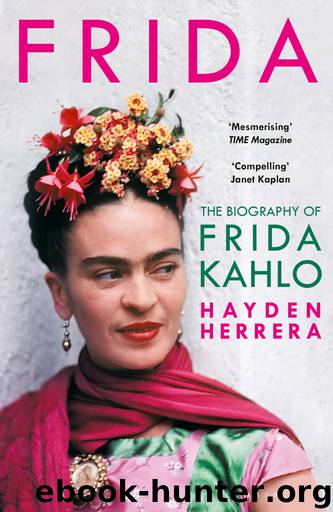Frida by Hayden Herrera

Author:Hayden Herrera
Language: eng
Format: epub, azw3
Publisher: Bloomsbury Publishing
Published: 2018-09-07T16:00:00+00:00
Chapter 18
Remarriage
ON MAY 24, 1940, Trotsky’s bedroom was machine-gunned by a group of Stalinists that included the painter David Alfaro Siqueiros. The assassination attempt failed—Trotsky and Natalia rolled behind their bed to escape the bullets. “They acted like firecracker makers,” said Frida of the assassins. “They killed a gringo called Shelton Harte, they buried him in the Desierto de los Leones, and they fled. Naturally the police caught them; they put Siqueiros in jail but Cárdenas was his cuate. " (Siqueiros was released less than a year later on the condition that he leave the country. He went to Chile to paint murals.)
Because of his much publicized falling-out with Trotsky, Rivera immediately came under suspicion, and not long after the assassination attempt, Paulette Goddard watched from her hotel window as the police assembled to cordon off the San Angel studio. She telephoned Rivera to warn him, and Irene Bohus, who was with him at the time, stuffed Diego onto the floor of her car, covered him with canvases, and drove right past Police Colonel de la Rosa and his thirty men. During his weeks in hiding, Paulette Goddard was, Rivera said, the only person (besides Irene) who knew his whereabouts. "[She] brought delicacies and wines on frequent visits. Her lovely presence alone was enough to make my retreat a delight.” Like Siqueiros, Rivera had his friends among government officials. Two of them discovered his hiding place and, as he told it, came to warn him that he was in danger and to give him a passport prepared for entry into the United States. “I quietly slipped out of Mexico and headed for San Francisco.” Actually, it was not such a quiet departure. Rivera left Mexico from the Mexico City airport, and he went with a regular passport and with the promise of a commission to paint a mural for the library of San Francisco Junior College—to paint it, in fact, in public, at Treasure Island, as part of the Golden Gate International Exposition’s “Art in Action” show.
Soon he was installed with Irene Bohus in a studio apartment at 49 Calhoun Street on Telegraph Hill. (He planned to put Bohus in his mural—she was to symbolize the woman artist—but she left his employ and his studio before his portrait of her was finished, because, it is said, her mother objected to her cohabiting with the artist without benefit of judge or clergy. Rivera substituted a portrait of Emmy Lou Packard, another assistant—one who did not inhabit his studio.)
With its theme of Pan-American Unity, the Treasure Island mural expressed Rivera’s current approach to politics. Though he had split from Trotsky, he remained (for a few years) an ardent anti-Stalinist, and after the Stalin-Hitler pact in 1939, he became an impassioned advocate of inter-American solidarity in opposition to totalitarianism. His real political aim, he told Sigmund Firestone in a letter dated January 30, 1941, was to establish “a common citizenship” for everybody in the Americas and to destroy the leading totalitarians of the era: Hitler, Mussolini, and Stalin.
Download
This site does not store any files on its server. We only index and link to content provided by other sites. Please contact the content providers to delete copyright contents if any and email us, we'll remove relevant links or contents immediately.
Cecilia; Or, Memoirs of an Heiress — Volume 3 by Fanny Burney(30934)
Cecilia; Or, Memoirs of an Heiress — Volume 2 by Fanny Burney(30889)
Fanny Burney by Claire Harman(25784)
We're Going to Need More Wine by Gabrielle Union(18072)
Plagued by Fire by Paul Hendrickson(16636)
Cat's cradle by Kurt Vonnegut(13866)
Bombshells: Glamour Girls of a Lifetime by Sullivan Steve(13108)
All the Missing Girls by Megan Miranda(12747)
Leonardo da Vinci by Walter Isaacson(11901)
4 3 2 1: A Novel by Paul Auster(11047)
Adultolescence by Gabbie Hanna(8145)
The remains of the day by Kazuo Ishiguro(7551)
Note to Self by Connor Franta(7024)
Diary of a Player by Brad Paisley(6866)
Giovanni's Room by James Baldwin(5877)
What Does This Button Do? by Bruce Dickinson(5527)
Recovery by Russell Brand(4564)
Born a Crime by Trevor Noah(4510)
The Kite Runner by Khaled Hosseini(4431)
